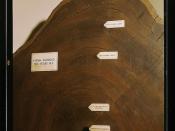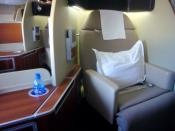Virgin vs. Qantas
In making a comparison of the offerings between the two airlines, Virgin and Qantas, there are a variety of methods one can use to show the differences between the services offered and their various prices, which will be looked at. Primarily, the marketing mix aspects of price and promotion will be concentrated on for this assignment when looking at various attributes, product description, pricing structure and product variations.
When comparing these two companies, one must look at brand image. To look at brand image in the aspect of these two very different airlines makes it easier to determine why they are so different and why their products and services differ so greatly. Both companies target different markets, Virgin targeting a market who are ready to save money in exchange for the lack of comfort and aesthetics, whilst Qantas target a market who prefer an aspect of prestige.
The image is reflected on the markets the two airlines target, in this case, budget versus quality.
Both Virgin and Qantas have tangible and intangible aspects of the products and services they provide their customers. The tangible aspects are visible from the airport terminals presented by the respective companies. Virgin's terminals look much more makeshift than that of the more prestigious Qantas. The feel of the Qantas terminal gives it's occupants more of a feel for the comfort they offer, which is just another reflection of the brand image of the two airlines.
The Qantas prices may be a bit dearer, but they do offer food and drinks at no extra cost, whereas Virgin sell foodstuffs during their flight, though the culinary aptitude of both companies leaves much to be desired, seemingly more so for Qantas, from my personal experiences. As for the seating and facilities, Qantas have a much more luxurious outlook, on both décor and their toilets, as well as accessibility and legroom. For a short trip like that of Adelaide to Melbourne, it wouldn't make much of a difference. There would be no in-flight movie so entertainment is virtually non-existent in any case.
The main intangible aspect for the airlines is the flight itself, and whether or not it runs smoothly. The visual scrappiness of Virgin's planes and terminals leaves much to be desired, and for many people may reflect the company's safety or apparent lack thereof. However, I find the confidence and playfulness of the flight crew and attendants reassuring, also making for a fun trip. Qantas take themselves much more seriously though, advertising the fact that they are notoriously, the world's safest airline.
Baggage control is a big issue for many air travelers, and is an intangible service provided by both airlines. From the outside, one would imagine that Qantas is much more organised due to the aesthetics of their conveyers. This, from my experiences, is not the case. Having traveled frequently on both airlines, I have found that Virgin's baggage handling service are much more efficient, as well as safer and quicker. On the odd occasion, I have had baggage lost or misplaced temporarily, only to be returned not long after by Qantas who deliver the luggage to me. This, however, has never occurred on a Virgin flight. This in itself, shows to me that Virgin are a well-oiled machine, in spite of how it appears on the exterior.
When comparing the actual flight package between Qantas and Virgin, one can find quite a bit of variation in the product being offered. One can tell just from the prices that Virgin tried extremely hard to give the customer a perception of a totally different image when they came on the market; a low budget airline. This is reflected in the quality of their terminals and the older planes that they use. The variations on airline travel that Virgin have implemented are many, including making passengers pay for meals on the plane and the seemingly poor interior of the planes themselves. One amazing difference between the two companies is the class structure. While Qantas have stuck with having economy, business and first class seating, Virgin have decided to have all their planes decked out with only economy style seating. It's this type of differentiation that makes them stand out to customers, primarily for their reputation of being a low-budget airline.
Virgin's angle of differentiation since they came onto the market has been that they are a cheaper company and openly sacrifice luxuries to prove it. As well as this, virgin only offer domestic flights within Australia, whereas Qantas venture into the international flights. Qantas, equally, have tried to differ from their competitor with their quality, whilst still attempting to match Virgin's cheap domestic rates. How long they can keep this up is debatable, but the fact is, Virgin's differentiation tactics have worked and the airline now seems to be in it for the long haul.
The pricing structure of these two conglomerates seems to be the main thing that people recognise them for. Virgin are notorious for their low prices and offer good deals on domestic flights. For example, a one-way flight from Adelaide to Melbourne would cost $79 for an adult on a Virgin plane. Qantas, however, offer the same flight for $89, and this includes a meal. Periodically, Virgin offers their 'sale destination' for each capital city, which for Adelaide this is week is to Canberra one-way, for $69. This offer is a very clever idea, and is good for travelers to whom date of departure isn't a great issue.
Qantas are offering lower-than-normal prices for them, in order to keep up with the cheap domestic fares offered by Virgin. Their low prices are also backed up by their offers on fly-buy points, which allows shoppers at various outlets free air travel if they purchase enough goods from these stores.
The low pricing structure is quite unusual for Qantas and is, to me, seemingly limited. On other domestic flights, Qantas are trying increasingly hard to keep their prices near to those offered by virgin, but I think this can only be kept up for a short period of time. Some time in the foreseeable future, Qantas would have to raise their prices again if they wish to be making a profit on flights, otherwise they would need to sacrifice luxury for low prices, as Virgin have done.
Virgin have pegged back their prices significantly, and have continued to do so as Qantas have tried their utmost to keep up. I think the price objective of the two airlines reflect their willingness to compete with one another for quite a large share of Australia's growing domestic air travelers. Sacrificing service and quality for price is a strategy, which has proved very successful, and one that Qantas have failed to do, which is why I believe their strategies would not be profitable for them. The fact that they have their international flights and reputation to fall back on is proving to be extremely important for them, but unless they think up a new strategy, Qantas will quickly fall by the wayside in regards to domestic travel within Australia.
The strategies used are using lower prices, which both companies have employed. There is a competitive advantage there for Qantas for the meantime, as they gain a loyal supporter base. But there's the issue of economy versus class, the latter being more business orientated, which is where most of Qantas' loyalty will spurn.
The pricing strategies above have not come without sacrifice. While keeping up with fundamental safety standards, Virgin have not added 1% when it comes to overall safety, their older, cheaper planes giving the perception of instability to the air traveler. The price war between these two companies has also meant lower profits for both airlines. This has taken its toll on the workers, leading to more workers having been layed off due to the overall decrease in profits for the domestic sector.
Equally, there have been positive affects on the airline industry. People have been able to travel cheaply, going on holidays within Australia (boosting internal tourism) as well as allowing people to visit relatives interstate, without having to worry about huge costs that thy had to before Virgin entered the Australia domestic airline market. As well as having boosted air travel, the pricing strategies by both companies has also given people the opportunity to view the country for less than the price of catching a bus in most cases, and much faster as well.
It seems as though both companies are marketing orientated, with a keen customer focus, competitor intelligence and aiming to maintain and create good customer relationships. Qantas seem to focus more on the three main aspects of quality, service and benefits, particularly the latter with many features and bonuses (such as meals and in-flight music) not offered by Virgin, it's major competitor. Virgin however, see these aspects as disposable in exchange for a great price, which has proved true in recent times, judging by their economic success. Out of the two companies, people tend to be more loyal to Qantas, seemingly a patriotism thing more than Qantas' attempts at building long-term relationships.
Both Virgin and Qantas airlines have various objectives and goals, using strategies and operational techniques to achieve these.
One such objective for Virgin would be to gain the majority market share for the domestic air travel market. In doing so, they could offer a fly-buys scheme with one of the large food outlets, such as Qantas have done, thus achieving brand loyalty amongst day-to-day shoppers. Operationally, the airline could go to Woolworths, a major competitor of Coles Myer, which would work well for both companies in opposition to one another.
While both airlines are extremely different, they both aim to reach a common goal: to get Australians from one place to another. In spite of pricing strategies, differentiation, various service components and variations of their products, both airlines have achieved their desired result.


